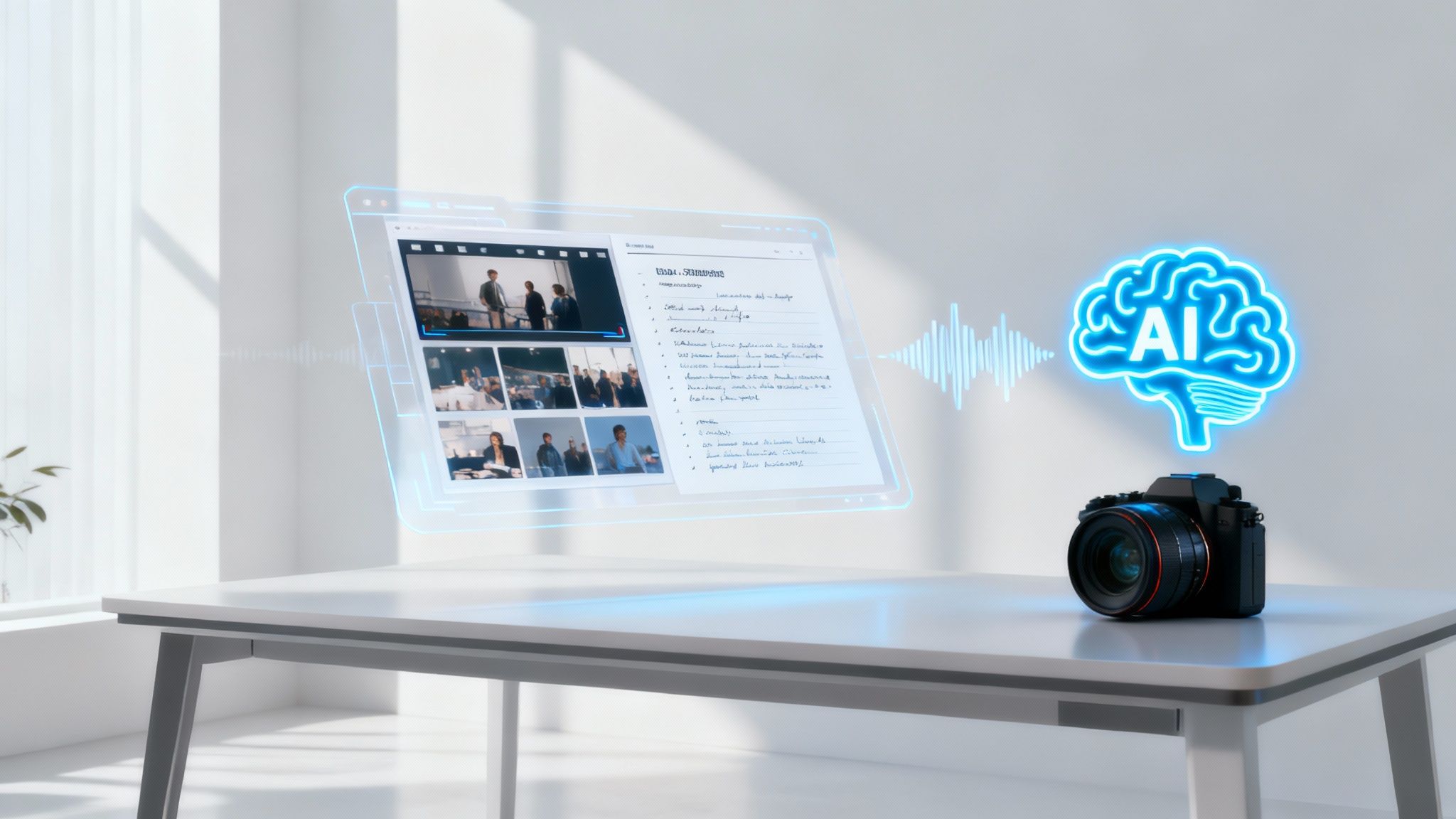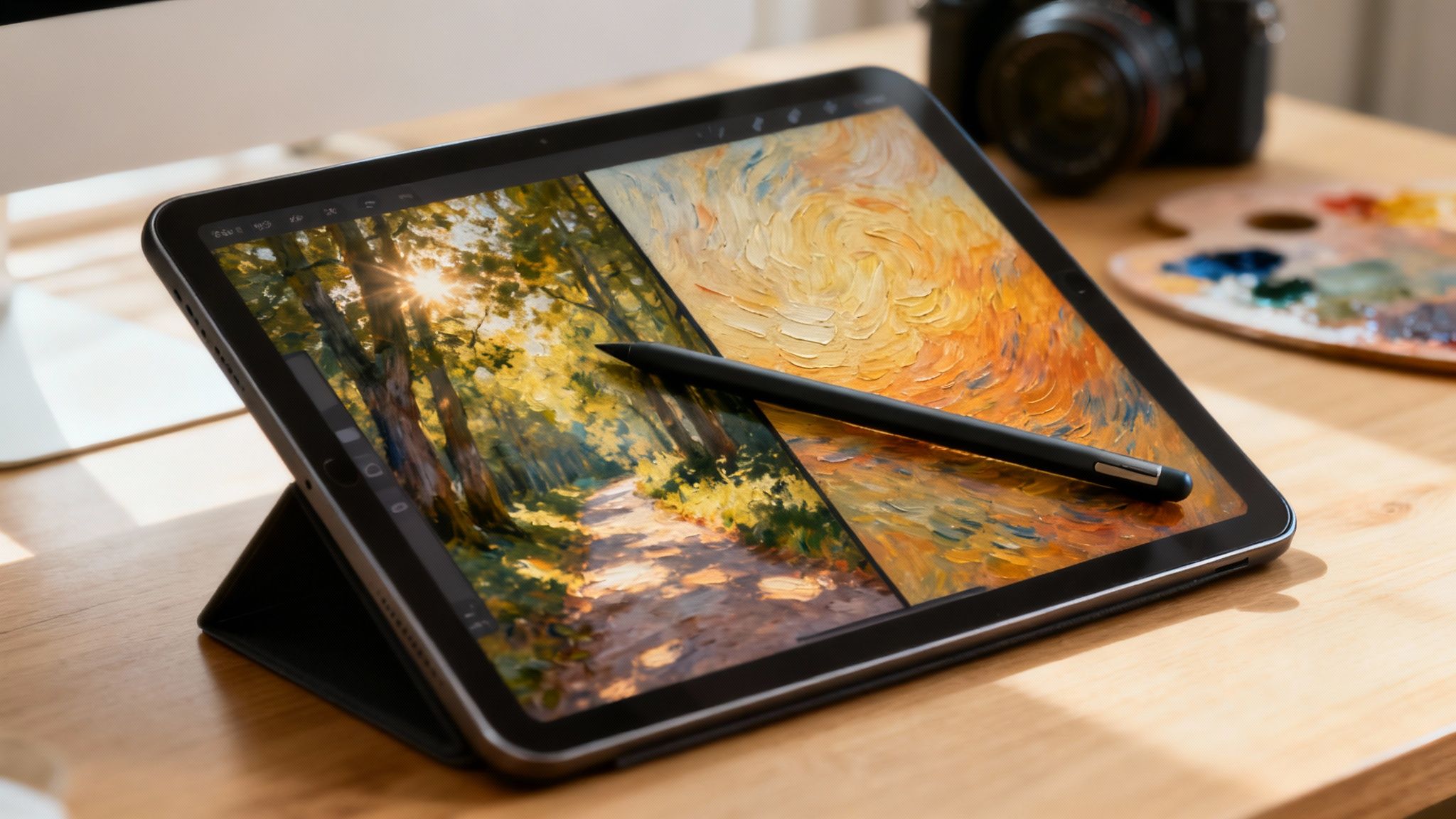
Meta Description: Learn how to create high-converting AI generated commercials. This guide covers strategy, scripting, visuals, and distribution to help you produce ads faster and cheaper.
Tired of the high costs and slow timelines of traditional commercial production? Many marketers and creators face creative bottlenecks, struggling to launch campaigns quickly. The good news is that AI generated commercials are changing the game. This technology offers a powerful solution, enabling brands to produce compelling ads faster, test more ideas, and slash budgets. This guide will walk you through the entire process, from crafting a smart strategy to getting your finished ad in front of the right audience.
What Are AI Generated Commercials? A New Era for Advertising
AI generated commercials are video ads created using artificial intelligence tools for scripting, storyboarding, visual creation, voiceovers, and music. This shift towards AI-powered advertising is reshaping marketing strategies from the ground up by making production more accessible and agile.
For marketers and agencies, this shift offers several game-changing benefits:
- Drastically Faster Production: Go from a simple concept to a finished commercial in hours or days, not weeks or months. This speed slashes your time-to-market.
- Significant Cost Savings: Say goodbye to massive film crews, expensive location scouting, and pricey equipment rentals. AI dramatically lowers production overhead.
- Limitless Creative Exploration: Effortlessly generate and A/B test dozens of ad variations—different scripts, visuals, or calls to action—to discover what truly connects with your audience.
Understanding how to use AI for marketing is the first step, and it’s far more accessible than you might think.
Step 1: Build Your AI Commercial Strategy
Jumping into AI tools without a solid plan is a common mistake. Crafting AI generated commercials that actually perform begins with a smart strategy that links every creative choice directly to your business objectives. Before writing a single prompt, you need to know who you're talking to, what you want them to do, and how you'll measure success. A clear strategy ensures your creative exploration remains focused and productive, turning AI's power into tangible results.
Define Your Audience and Goals
First, get crystal clear on your target audience. Go beyond basic demographics and build detailed personas. What are their biggest pain points? Where do they spend their time online? What content makes them stop scrolling? An AI can generate endless variations, but it needs your human insight to create a message that resonates with a 25-year-old startup founder versus a 50-year-old marketing executive.
Next, set specific, measurable campaign goals. Are you trying to achieve:
- Brand Awareness: Introducing your brand to a new market.
- Lead Generation: Driving sign-ups for a webinar or free trial.
- Direct Sales: Encouraging viewers to click "buy now" on a product.
Your goal dictates the entire tone and call to action of your ad. An awareness campaign might be emotional and story-driven, while a sales-focused ad needs to be direct, benefit-packed, and create a sense of urgency.
Craft a Core Message and Budget
With your audience and goals defined, what’s the one key takeaway you want viewers to remember? This is your core message—your unique value proposition. Keep it simple and compelling. For example, instead of "Our software has advanced features," a stronger message is "Our software saves you 10 hours of manual work every week."
Budgeting for AI commercials is different. You’ll save on crew and equipment, but you need to factor in AI tool subscriptions, asset licensing fees, and your team's time for prompting and editing. A realistic budget upfront helps you allocate resources effectively.
How AI Augments Traditional Planning
The strategic framework is familiar, but AI supercharges the execution. The biggest change is the speed and scale at which you can test ideas. Instead of betting your entire budget on one concept, you can now explore a dozen creative directions simultaneously.
| Planning Stage | Traditional Approach | AI-Augmented Approach |
|---|---|---|
| Concept Brainstorming | A small team develops a few core ideas. | Generates dozens of concepts, taglines, and visual styles from a single prompt. |
| Storyboarding | A manual, time-consuming process requiring an artist. | AI tools create visual storyboards from text in minutes for rapid iteration. |
| Budget Allocation | Heavily weighted toward physical production costs. | Shifts focus to software subscriptions, prompt engineering, and post-production. |
Step 2: Write Your Script with AI
With your strategy in place, it's time to bring your commercial to life with a script. This is where your core message gains a voice through compelling storytelling and a clear call to action. Instead of staring at a blank page, you can use AI to generate multiple creative starting points in minutes. The key is mastering the art of the prompt—providing detailed instructions that bridge your marketing goals and the AI's creative engine. This transforms your role from writer to creative director, guiding the AI to produce narratives that connect.
Master the Art of the Prompt
A prompt is a creative brief for your AI assistant. The more context you provide, the better the output. A vague request like "Write a commercial script" will yield a generic, forgettable ad. A great prompt for AI generated commercials includes:
- Target Audience: Who are you talking to? (e.g., "millennial gamers," "busy B2B marketing managers").
- Product/Service & Problem: What is it and what does it solve? (e.g., "a mobile banking app that automates savings").
- Core Message: What is the one key takeaway? (e.g., "effortless saving without thinking about it").
- Tone of Voice: How should it feel? (e.g., "humorous and relatable," "urgent and professional").
- Call to Action (CTA): What is the next step for the viewer? (e.g., "download the app," "book a demo").
- Length: A snappy 15-second spot or a more detailed 30-second commercial?
Real-World Prompting Examples
Let's imagine you're marketing "FlowState," a project management tool for burnt-out startup teams.
Example 1: Humorous & Relatable (Targeting team members)
Prompt: "Write a 30-second commercial script for FlowState, a project management tool. The audience is overworked startup employees drowning in spreadsheets and Slack notifications. The tone should be humorous and empathetic. The core message is that FlowState brings order to chaos. End with a call to action to try it for free."
Example 2: Urgent & Professional (Targeting founders)
Prompt: "Create a 15-second commercial script for FlowState, an AI-powered project management platform. The audience is startup founders concerned about missing deadlines. The tone is professional and benefit-driven. Highlight how FlowState saves an average of 10 hours per week. The CTA is 'Book a demo to see your ROI'."
These prompts produce vastly different scripts by targeting distinct pain points and tones. Improving your prompts is key, and reviewing copywriting tips for beginners can help.
Step 3: Create Your Visuals with AI
With a killer script ready, it's time to create the visuals. This is where your AI generated commercials truly take shape. You’ll act as the director, guiding AI tools to build your ad scene by scene, starting with a digital storyboard. By translating each scene into a detailed prompt for an AI image or video generator, you can mock up shots, experiment with camera angles, and define the visual style before generating the final video clips.
Craft Compelling Visuals from Prompts
To create a great visual storyboard, your prompts need to be specific. A generic prompt like "a person using a laptop" will produce a bland result. Think like a cinematographer and pack your prompts with detail and emotion. For our "FlowState" example, instead of "Stressed employee at a desk," use a stronger prompt:
"Overhead shot of a young professional in a modern, cluttered office at night. They're slumped over a glowing laptop, one hand running through their hair in frustration. The only light comes from the monitor, casting long shadows. Photorealistic, cinematic lighting, 4K."
This detailed prompt provides clear instructions on camera angle, character emotion, lighting, and style, resulting in a much more compelling image. Explore the best AI tools for content creation to find what fits your workflow.
Maintain Visual Consistency Across Scenes
A common challenge with AI generated commercials is maintaining a consistent look. It’s easy for characters and settings to vary from shot to shot. To avoid this:
- Use Seed Numbers: Many AI generators let you use a "seed number" to start from a similar visual point for multiple prompts.
- Reference Previous Images: Advanced tools allow you to upload a generated image as a reference to lock in a character's appearance or art style for subsequent shots.
- Develop a Style Guide Prompt: Create a "master" style description to add to every prompt, such as "...style: vibrant, flat 2D animation, with bold outlines and a pastel color palette, inspired by modern corporate explainer videos."
These techniques create a unified visual language, giving your ad a polished feel. The Interactive Advertising Bureau (IAB) found that nearly 86% of advertisers were using or planning to use generative AI for video ads. You can read the full research about GenAI in advertising on iab.com.
Step 4: Polish Your Ad with Audio and Editing
Even the most stunning visuals can fall flat if the audio is off. A robotic voiceover or generic stock music can make your production feel cheap. AI audio and editing tools add the final professional sheen. Modern AI platforms produce incredibly realistic voiceovers that capture genuine emotion and custom, royalty-free soundtracks that perfectly match your ad's mood. These tools are a key reason why the AI marketing sector, valued at $47.32 billion USD in 2025, is projected to hit $107.5 billion by 2028, according to this report on AI marketing statistics from seo.com.
Generate a Lifelike AI Voiceover
The human voice is your most powerful tool for emotional connection. With AI voice platforms like MediaWorkbench.ai, you gain access to a massive library of voices. Think like a casting director:
- Match the Voice to Your Audience: Does the voice resonate? A warm, friendly tone works for a consumer brand, while a crisp, authoritative voice suits B2B software.
- Fine-Tune the Emotion: Dial up the excitement for a product reveal or inject empathy when discussing a customer's problem.
- Control the Pacing: Use AI controls to add strategic pauses after key points, giving the message time to sink in.
Compose the Perfect AI Soundtrack
Music sets the mood and drives the action, but licensing is often a headache. AI music generators solve this by creating new compositions based on your instructions. Simply define the:
- Mood: Uplifting, dramatic, or playful.
- Genre: Cinematic, electronic, or acoustic.
- Pacing: A slow build or high-energy from the start.
The AI generates a unique track timed to your ad, ensuring the music swells and fades in all the right places for a polished, professional finish that once required an audio editor.
Step 5: Distribute and Analyze Your Commercial
Creating a stunning AI generated commercial is a huge win, but an ad that never finds its audience is just a file on your hard drive. The final step is getting your masterpiece in front of the right people and using data to understand what works. This is where you turn creative output into measurable business impact.
Smart Distribution and Scheduling
The "spray and pray" advertising method is dead. Precision is everything. AI analytics tools can sift through massive datasets to show you where your ideal customers are online—be it TikTok, YouTube, or LinkedIn. Once you know where to post, a platform like MediaWorkbench.ai helps you nail the when. You can schedule your entire campaign to deploy during peak engagement hours and maintain a consistent message across all channels automatically. For more on this, check out our guide on marketing automation best practices.
Measure What Matters with AI Analytics
As soon as your commercial goes live, the learning begins. AI-powered dashboards monitor your key performance indicators (KPIs) in real-time, turning raw data into clear insights. Key metrics to watch include:
- Click-Through Rate (CTR): The percentage of viewers who clicked your ad. A high CTR signals your creative is compelling.
- Conversion Rate: How many clicks led to a desired action (a sale, signup, or download). Solid conversion tracking strategies are essential here.
- Return on Ad Spend (ROAS): The ultimate report card. For every dollar you put in, how much did you get back?
Data shows that AI-optimized creatives can deliver up to double the click-through rates of manual versions. Businesses are also seeing an average 50% increase in ROAS by using AI-generated ads. You can discover more insights about AI creative performance on amraandelma.com.
Conclusion: Your New Creative Workflow Awaits
Making AI generated commercials is no longer a futuristic concept—it's a practical, powerful strategy available to creators, marketers, and agencies today. We've walked through the five key steps: building a solid strategy, writing a compelling script, creating stunning visuals, polishing the audio, and analyzing performance. By blending human creativity with AI's speed and scale, you can overcome traditional production hurdles like high costs and slow timelines. This new workflow empowers you to test more ideas, connect with your audience on a deeper level, and ultimately drive better results for your business.
Ready to create stunning commercials in minutes? Media Workbench AI gives you all the tools you need to go from idea to a fully polished ad. Generate scripts, visuals, and voiceovers in one unified platform.
👉 Try Media Workbench AI for free and start creating today!

